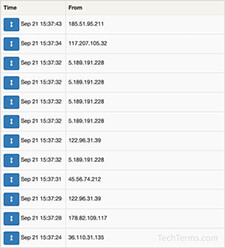IP Address
An IP address, or simply an "IP," is a unique address that identifies a device on the Internet or a local network. It allows a system to be recognized by other systems connected via the Internet protocol. There are two primary types of IP address formats used today — IPv4 and IPv6.
IPv4
An IPv4 address consists of four sets of numbers from 0 to 255, separated by three dots. For example, the IP address of TechTerms.com is 67.43.14.98. This number is used to identify the TechTerms website on the Internet. When you visit http://techterms.com in your web browser, the DNS system automatically translates the domain name "techterms.com" to the IP address "67.43.14.98."
There are three classes of IPv4 address sets that can be registered through the InterNIC. The smallest is Class C, which consists of 256 IP addresses (e.g., 123.123.123.xxx — where xxx is 0 to 255). The next largest is Class B, which contains 65,536 IP addresses (e.g. 123.123.xxx.xxx). The largest block is Class A, which contains 16,777,216 IP addresses (e.g. 123.xxx.xxx.xxx).
The total number of IPv4 addresses ranges from 000.000.000.000 to 255.255.255.255. Because 256 = 28, there are 28 x 4 or 4,294,967,296 possible IP addresses. While this may seem like a large number, it is no longer enough to cover all the devices connected to the Internet around the world. Therefore, many devices now use IPv6 addresses.
IPv6
The IPv6 address format is much different than the IPv4 format. It contains eight sets of four hexadecimal digits and uses colons to separate each block. An example of an IPv6 address is: 2602:0445:0000:0000:a93e:5ca7:81e2:5f9d. There are 3.4 x 1038 or 340 undecillion) possible IPv6 addresses, meaning we shouldn't run out of IPv6 addresses anytime soon.
 Test Your Knowledge
Test Your Knowledge